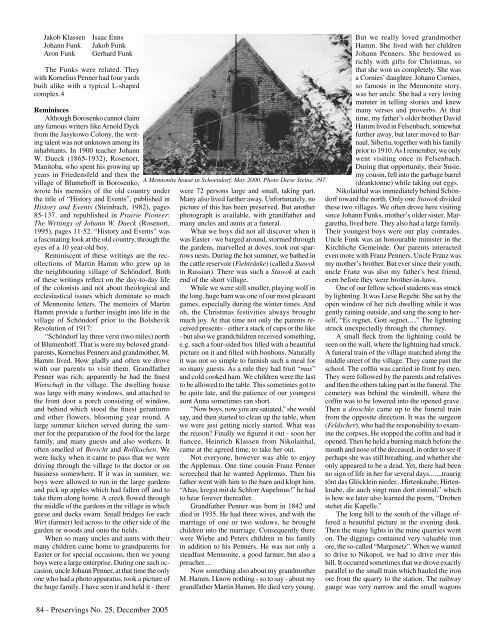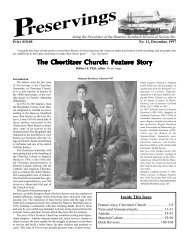Preservings $20 No. 25, December, 2005 - Plett Foundation
Preservings $20 No. 25, December, 2005 - Plett Foundation
Preservings $20 No. 25, December, 2005 - Plett Foundation
You also want an ePaper? Increase the reach of your titles
YUMPU automatically turns print PDFs into web optimized ePapers that Google loves.
Jakob Klassen Isaac Enns<br />
Johann Funk Jakob Funk<br />
Aron Funk Gerhard Funk<br />
The Funks were related. They<br />
with Kornelius Penner had four yards<br />
built alike with a typical L-shaped<br />
complex.4<br />
Reminisces<br />
Although Borosenko cannot claim<br />
any famous writers like Arnold Dyck<br />
from the Jasykowo Colony, the writing<br />
talent was not unknown among its<br />
inhabitants. In 1900 teacher Johann<br />
W. Dueck (1865-1932), Rosenort,<br />
Manitoba, who spent his growing up<br />
years in Friedensfeld and then the<br />
village of Blumehoff in Borosenko,<br />
wrote his memoirs of the old country under<br />
the title of “History and Events”, published in<br />
History and Events (Steinbach, 1982), pages<br />
85-137, and republished in Prairie Pioneer:<br />
The Writings of Johann W. Dueck (Rosenort,<br />
1995), pages 11-52. “History and Events” was<br />
a fascinating look at the old country, through the<br />
eyes of a 10 year-old boy.<br />
Reminiscent of these writings are the recollections<br />
of Martin Hamm who grew up in<br />
the neighbouring village of Schöndorf. Both<br />
of these writings reflect on the day-to-day life<br />
of the colonists and not about theological and<br />
ecclesiastical issues which dominate so much<br />
of Mennonite letters. The memoirs of Martin<br />
Hamm provide a further insight into life in the<br />
village of Schöndorf prior to the Bolshevik<br />
Revolution of 1917:<br />
“Schöndorf lay three verst (two miles) north<br />
of Blumenhoff. That is were my beloved grandparents,<br />
Kornelius Penners and grandmother, M.<br />
Hamm lived. How gladly and often we drove<br />
with our parents to visit them. Grandfather<br />
Penner was rich; apparently he had the finest<br />
Wirtschaft in the village. The dwelling house<br />
was large with many windows, and attached to<br />
the front door a porch consisting of window,<br />
and behind which stood the finest geraniums<br />
and other flowers, blooming year round. A<br />
large summer kitchen served during the summer<br />
for the preparation of the food for the large<br />
family, and many guests and also workers. It<br />
often smelled of Borscht and Rollkuchen. We<br />
were lucky when it came to pass that we were<br />
driving through the village to the doctor or on<br />
business somewhere. If it was in summer, we<br />
boys were allowed to run in the large gardens<br />
and pick up apples which had fallen off and to<br />
take them along home. A creek flowed through<br />
the middle of the gardens in the village in which<br />
geese and ducks swam. Small bridges for each<br />
Wirt (farmer) led across to the other side of the<br />
garden or woods and onto the fields.<br />
When so many uncles and aunts with their<br />
many children came home to grandparents for<br />
Easter or for special occasions, then we young<br />
boys were a large enterprise. During one such occasion,<br />
uncle Johann Penner, at that time the only<br />
one who had a photo apparatus, took a picture of<br />
the huge family. I have seen it and held it - there<br />
84 - <strong>Preservings</strong> <strong>No</strong>. <strong>25</strong>, <strong>December</strong> <strong>2005</strong><br />
A Mennonite house in Schoendorf, May 2000. Photo Diese Steine, 397.<br />
were 72 persons large and small, taking part.<br />
Many also lived farther away. Unfortunately, no<br />
picture of this has been preserved. But another<br />
photograph is available, with grandfather and<br />
many uncles and aunts at a funeral.<br />
What we boys did not all discover when it<br />
was Easter - we barged around, stormed through<br />
the gardens, marvelled at doves, took out sparrows<br />
nests. During the hot summer, we bathed in<br />
the cattle reservoir (Fiehtränke) (called a Stawok<br />
in Russian). There was such a Stawok at each<br />
end of the short village.<br />
While we were still smaller, playing wolf in<br />
the long, huge barn was one of our most pleasant<br />
games, especially during the winter times. And<br />
oh, the Christmas festivities always brought<br />
much joy. At that time not only the parents received<br />
presents - either a stack of cups or the like<br />
- but also we grandchildren received something,<br />
e.g. such a four-sided box filled with a beautiful<br />
picture on it and filled with bonbons. Naturally<br />
it was not so simple to furnish such a meal for<br />
so many guests. As a rule they had fruit “mus”<br />
and cold cooked ham. We children were the last<br />
to be allowed to the table. This sometimes got to<br />
be quite late, and the patience of our youngest<br />
aunt Anna sometimes ran short.<br />
“<strong>No</strong>w boys, now you are satiated,” she would<br />
say, and then started to clean up the table, when<br />
we were just getting nicely started. What was<br />
the reason? Finally we figured it out - soon her<br />
fiancee, Heinrich Klassen from Nikolaithal,<br />
came at the agreed time, to take her out.<br />
<strong>No</strong>t everyone, however was able to enjoy<br />
the Applemus. One time cousin Franz Penner<br />
screeched that he wanted Applemus. Then his<br />
father went with him to the barn and klopt him.<br />
“Ahas, kregst mit de Schlorr Aupelmus!” he had<br />
to hear forever thereafter.<br />
Grandfather Penner was born in 1842 and<br />
died in 1935. He had three wives, and with the<br />
marriage of one or two widows, he brought<br />
children into the marriage. Consequently there<br />
were Wiebe and Peters children in his family<br />
in addition to his Penners. He was not only a<br />
steadfast Mennonite, a good farmer, but also a<br />
preacher....<br />
<strong>No</strong>w something also about my grandmother<br />
M. Hamm. I know nothing - so to say - about my<br />
grandfather Martin Hamm. He died very young.<br />
But we really loved grandmother<br />
Hamm. She lived with her children<br />
Johann Penners. She bestowed us<br />
richly with gifts for Christmas, so<br />
that she won us completely. She was<br />
a Cornies’ daughter. Johann Cornies,<br />
so famous in the Mennonite story,<br />
was her uncle. She had a very loving<br />
manner in telling stories and knew<br />
many verses and proverbs. At that<br />
time, my father’s older brother David<br />
Hamm lived in Felsenbach, somewhat<br />
further away, but later moved to Barnaul,<br />
Siberia, together with his family<br />
prior to 1910. As I remember, we only<br />
went visiting once in Felsenbach.<br />
During that opportunity, their Susie,<br />
my cousin, fell into the garbage barrel<br />
(dranktonne) while taking out eggs.<br />
Nikolaithal was immediately behind Schöndorf<br />
toward the north. Only one Stawok divided<br />
these two villages. We often drove here visiting<br />
since Johann Funks, mother’s older sister, Margaretha,<br />
lived here. They also had a large family.<br />
Their youngest boys were our play comrades.<br />
Uncle Funk was an honourable minister in the<br />
Kirchliche Gemeinde. Our parents interacted<br />
even more with Franz Penners. Uncle Franz was<br />
my mother’s brother. But ever since their youth,<br />
uncle Franz was also my father’s best friend,<br />
even before they were brother-in-laws.<br />
One of our fellow school students was struck<br />
by lightning. It was Liese Regehr. She sat by the<br />
open window of her rich dwelling while it was<br />
gently raining outside, and sang the song to herself,<br />
“Es regnet, Gott segnet.....” The lightning<br />
struck unexpectedly through the chimney.<br />
A small fleck from the lightning could be<br />
seen on the wall, where the lightning had struck.<br />
A funeral train of the village marched along the<br />
middle street of the village. They came past the<br />
school. The coffin was carried in front by men.<br />
They were followed by the parents and relatives<br />
and then the others taking part in the funeral. The<br />
cemetery was behind the windmill, where the<br />
coffin was to be lowered into the opened grave.<br />
Then a droschke came up to the funeral train<br />
from the opposite direction. It was the surgeon<br />
(Feldscher), who had the responsibility to examine<br />
the corpses. He stopped the coffin and had it<br />
opened. Then he held a burning match before the<br />
mouth and nose of the deceased, in order to see if<br />
perhaps she was still breathing, and whether she<br />
only appeared to be a dead. Yet, there had been<br />
no sign of life in her for several days.....,,traurig<br />
tönt das Glöcklein nieder...Hirtenknabe, Hirtenknabe,<br />
dir auch singt man dort einmal,” which<br />
is how we later also learned the poem, “Droben<br />
stehet die Kapelle.”<br />
The long hill to the south of the village offered<br />
a beautiful picture in the evening dusk.<br />
Then the many lights in the mine quarries went<br />
on. The diggings contained very valuable iron<br />
ore, the so-called “Margenetz”. When we wanted<br />
to drive to Nikopol, we had to drive over this<br />
hill. It occurred sometimes that we drove exactly<br />
parallel to the small train which hauled the iron<br />
ore from the quarry to the station. The railway<br />
gauge was very narrow and the small wagons

















